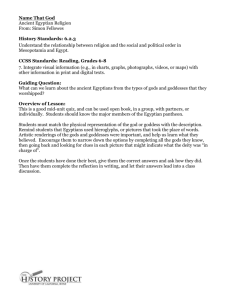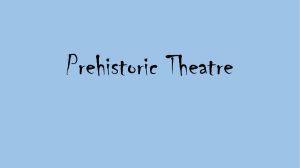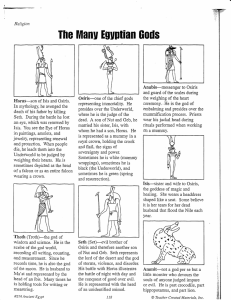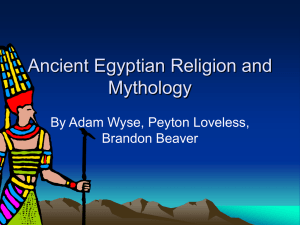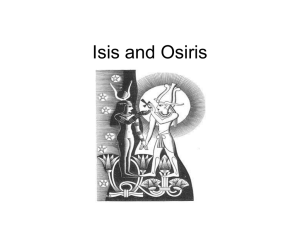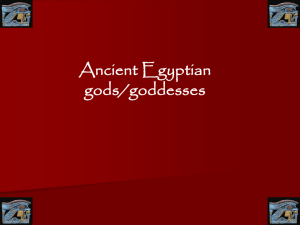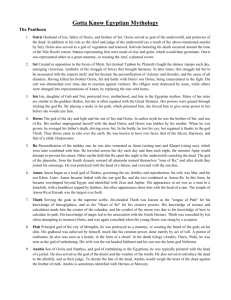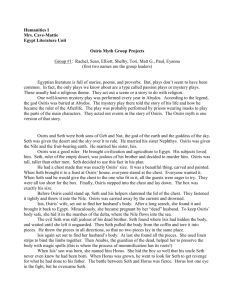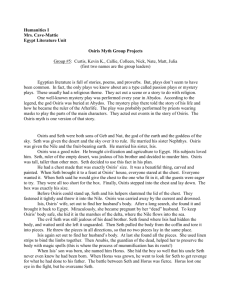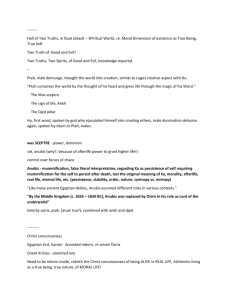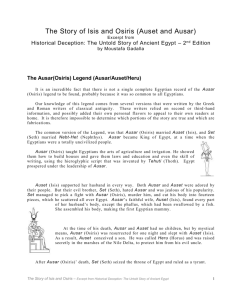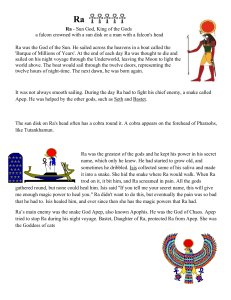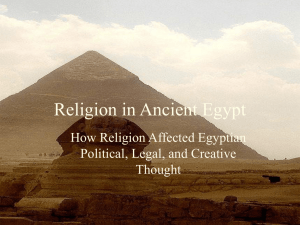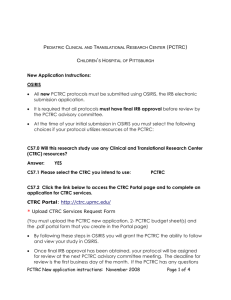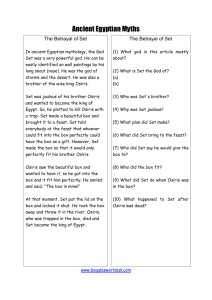Sample Layout for Research Paper
advertisement
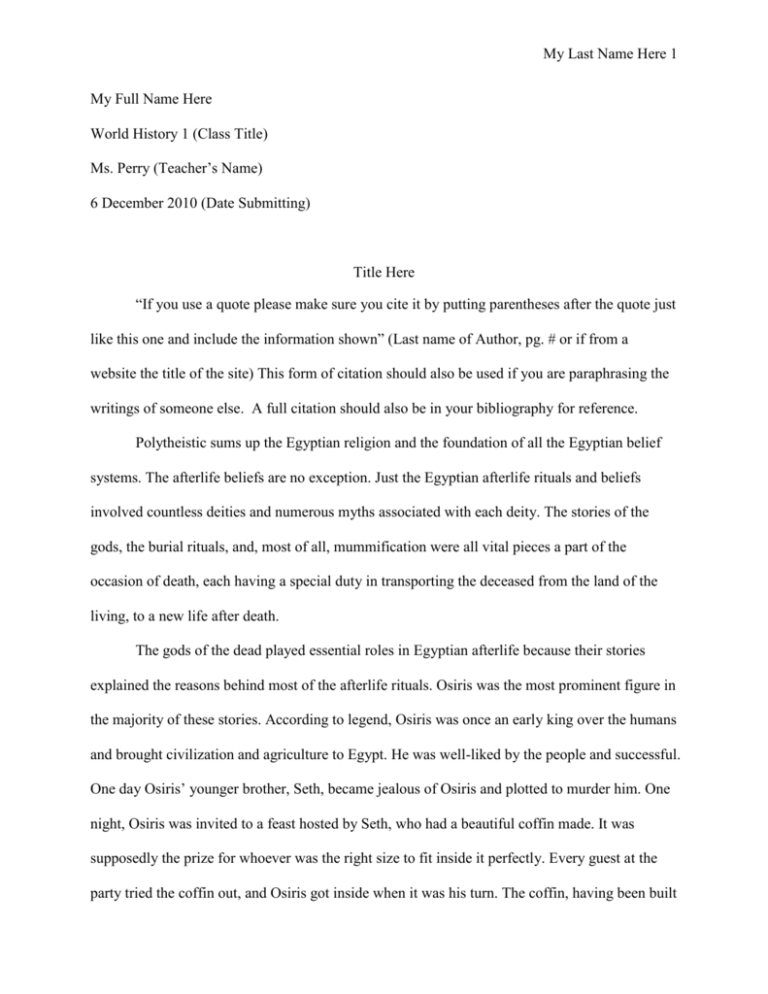
My Last Name Here 1 My Full Name Here World History 1 (Class Title) Ms. Perry (Teacher’s Name) 6 December 2010 (Date Submitting) Title Here “If you use a quote please make sure you cite it by putting parentheses after the quote just like this one and include the information shown” (Last name of Author, pg. # or if from a website the title of the site) This form of citation should also be used if you are paraphrasing the writings of someone else. A full citation should also be in your bibliography for reference. Polytheistic sums up the Egyptian religion and the foundation of all the Egyptian belief systems. The afterlife beliefs are no exception. Just the Egyptian afterlife rituals and beliefs involved countless deities and numerous myths associated with each deity. The stories of the gods, the burial rituals, and, most of all, mummification were all vital pieces a part of the occasion of death, each having a special duty in transporting the deceased from the land of the living, to a new life after death. The gods of the dead played essential roles in Egyptian afterlife because their stories explained the reasons behind most of the afterlife rituals. Osiris was the most prominent figure in the majority of these stories. According to legend, Osiris was once an early king over the humans and brought civilization and agriculture to Egypt. He was well-liked by the people and successful. One day Osiris’ younger brother, Seth, became jealous of Osiris and plotted to murder him. One night, Osiris was invited to a feast hosted by Seth, who had a beautiful coffin made. It was supposedly the prize for whoever was the right size to fit inside it perfectly. Every guest at the party tried the coffin out, and Osiris got inside when it was his turn. The coffin, having been built My Last Name Here 2 after Seth learned his measurements, fit Osiris perfectly. Immediately after his brother was inside, Seth nailed the coffin shut, and it was tossed into the Nile River. Eventually Osiris’ wife, Isis, heard about what happened, found Osiris’ body, and mourned over it. Seth discovered the body also, and cut it up into fourteen pieces. The pieces were scattered, and Isis spent many years finding every piece again. With help from other gods, Isis magically resurrected Osiris, who was not strong enough to return as king. He became the god of the Underworld, forever judging those who have died. The Egyptians favored Osiris because of the belief that he would give everyone a chance of an afterlife, not just pharaohs. Horus is a god who Isis gave birth to after Osiris was murdered. (Also called “Horus the Child”) Horus finds out what happened to Osiris and wants revenge on Seth. Seth repeatedly assaults Horus, but Isis cures him of all injuries. This is why the image of Horus is the standard feature for healing spells. Horus and Seth compete for Osiris’ throne and Horus eventually wins and becomes the King of the Living. Seth, known as the “Evil One”, is banished as an outcast. Anubis is also a notable god in the afterlife myths. Known as the god of the Dead, Anubis appears as a human with a jackal head-associated with mummification. The black color of Anubis symbolizes the color of rotting flesh and the soil of the Nile Valley (rebirth). In the Old Kingdom, Anubis was the most important god of the dead and the god of the Underworld, but was replaced in the Middle Kingdom by Osiris. He is known as the god of embalming- embalmed Osiris when Osiris was cut in fourteen pieces. Anubis is also one of the many protectors of the deceased and their tombs. The Egyptians have innumerable rituals associated with the afterlife, which were modified frequently over the years so they were more practical and possible to actually carry out. Mummification was by far the most prominent among the rituals. Preserving the corpse was My Last Name Here 3 believed to be essential for the continuation of life after death. Wrapping the body in linens coated with resin was an imitation of what happened to Osiris. This was also the first method of stopping the natural decay. “True Mummification” was devised in the Fourth Dynasty when the process of desiccation by natron was discovered and the basis of chemical mummification for the next several years started. One of the first steps of mummifying the corpse was to remove all the intestines and organs from the body-except the heart. The heart remained in the body and was important to the person’s afterlife. In the fourth century A.D. mummification was denounced and discontinued because its pagan associations. The deceased had many steps to go through before actually making it to the afterlife. The Book of the Dead (a book placed inside most coffins; filled with spells to pass the tests and perils of the underworld) was used to assist them past the dangers of Duat to the trial. The trial took place in the Hall of Two Truths in the presence of the divine judges (a tribunal of forty-two gods). The dead then had to recite the Negative Confession declaring their innocence. The heart of the dead person was weighed against the feather of truth to see if the person had lied. A light heart meant innocence- perfect balance with the feather. A person found honest would pass into Osiris’ eternal kingdom, and those not found honest would be thrown to a composite creature called the “devourer” and would cease to exist. The Egyptians believed in communicating with relatives or friends who had died. They believed that it was possible to talk to deceased relatives and took full advantage of that. The dead were seen as intermediaries between surviving relatives and the gods. The dead’s spirit was equipped with divine powers and could be persuaded by relatives with offerings and prayers. Most communication was through letters. The letters could include matters from personal guilt, to issues of family inheritance. My Last Name Here 4 Studying the life of Egyptians would lead one to think that these people were obsessed with death. The plethora of rituals and gods of the dead can be seen as misleading, however as some view the Egyptians as obsessed with the depressing issue of death, others see the focus on life and hope for life, even after the event of death. The people of ancient Egypt may have just seen death as an unpleasant requirement to make it to a new life in a happier place. My Last Name Here 5 Bibliography David, Rosalie. Handbook to Life in Ancient Egypt. New York: Facts on File, Inc., 1998. Print. Hart, George. Eyewitness Books Ancient Egypt. New York: Alfred A. Knopf, Inc., 1990. Print. Koeing, Vivlane and Veronique Ageorges. The Ancient Egyptians Life in the Nile Valley. Brookfield, Connecticut: The Millbrook Press, 1992. Print. Martson, Elsa. The Ancient Egyptians. New York: Marshall Cavendish Corporation, 1996. Print. Ritner, Robert. Ancient Egypt. Ed. David Silverman. London: Duncan Baird Publishers, 1997. Print. Terzi, Marinella. The Land of the Pharaohs. Ed. Ann Heinrichs. Chicago: Children’s Press Inc., 1992. Print. Watterson, Barbara. The Gods of Ancient Egypt. Stroud, England: Sutton Publishing Ldt., 2003. Print. White, John Manchip. Everyday Life in Ancient Egypt. New York: Hippocrene Books, 1990. Print.
